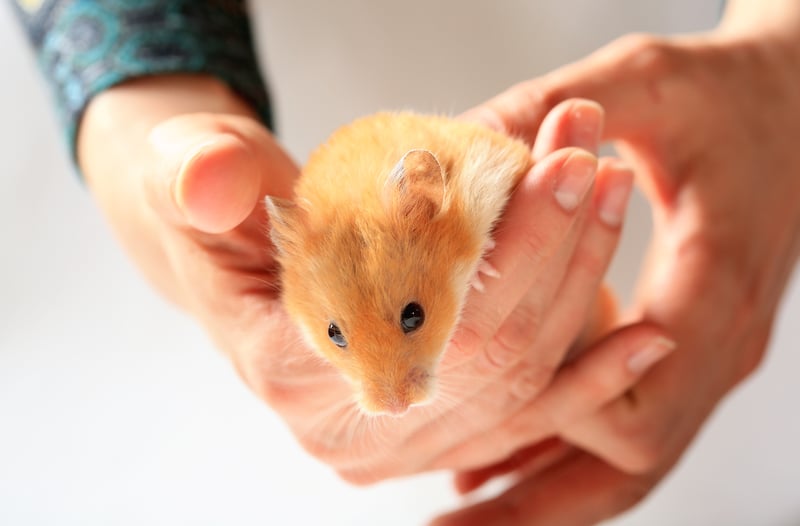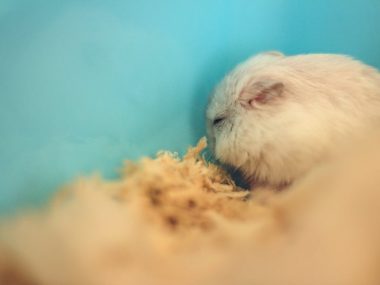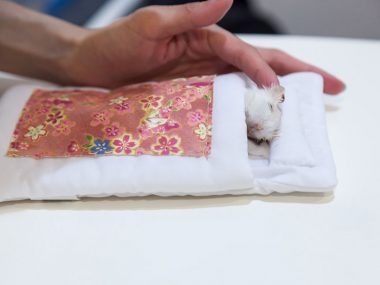Nobody likes to be cold, and that includes our furry little fluffballs. Hamsters are highly susceptible to low temperatures and can quickly get sick if they get cold. On the flip side, overheating is also dangerous. We have created this handy guide to keep your hamster healthy and active no matter the outside temperature.
The best temperature for hamsters is between 65 – 75°F (~18.5 – 24°C). Temperatures below 60°F (15°C) may cause the hamster to enter a state referred to as torpor, which is similar to hibernation. Prolonged cold may result in dehydration or hypothermia. High temperatures can cause heatstroke and may be fatal.
Hamsters need to live in a pretty specific temperature zone to keep them healthy and energetic. Luckily their comfort zone is pretty similar to humans, which is just another reason they are ideal pets!
Let’s find out how to create the ideal environment for your little pet and keep it warm and comfy even when it is chilly outside.
Table of Contents
Hamster Temperature – Why Is It Important?
Hamsters are not able to cope with extremes in temperature. They coast along comfortably in their ideal hammie-zone of between 65 and 75F. Any big swings out of that range are likely to cause extreme discomfort and may even be fatal.
It is essential that owners keep tabs on the temperature gauge and ensure that their little pets stay warm and comfortable. Since problems can arise when your hamster is either too hot or too cold, let’s look at some common warning symptoms that your pet may be in temperature-related distress.
| Signs That Your Hamster Is Too Cold | Symptoms Of Overheating |
|---|---|
| Shivering | Rapid breathing |
| It may seem lethargic | Lethargic |
| Its paws and nose may feel cold | Staying out in the open more than usual |
| May not be eating or drinking | Trembling |
| May appear to be having trouble breathing | Depression |
| The hamster may enter a state similar to hibernation and may even appear to be dead. | Convulsions |
All temperature-related symptoms are serious, but keeping your hamster comfortable isn’t difficult. There are stacks of things you can do to keep your tiny furball enjoying life no matter the season.
Many people believe that when hamsters get too cold, they will automatically drift off into a harmless state of temporary hibernation. The truth is that well-kept pet hamsters should never hibernate. It is a strategy used by wild hamsters to conserve energy and cope with harsh conditions.
Learn more about hamster hibernation, but it is a condition to be avoided. A pampered pet hammie that is kept warm and has a plentiful supply of healthy food should remain alert and active throughout its life. In particular dwarf hamster breeds never hibernate, even in the wild.
Do Hamsters Actually Hibernate?
A cold hamster may enter a state of torpor. This is slightly different from true hibernation because it’s a sudden (and hopefully short) period where its metabolic rate slows down to conserve energy. There may not have been a run-up or active fat-storing period before the shutdown, and it is simply a response to the drop in temperature or lack of food.
The danger is that a tiny hamster body isn’t padded up like a sleepy bear before it enters its den before winter. Torpor can occur in any season and is a physical response to unsuitable conditions.
Besides potentially getting pneumonia, a cold hamster will not eat or drink enough (or at all) and will quickly dehydrate.
But let’s not dwell on the negative! There are lots of easy ways to keep your little pet warm and cozy even when winter rolls around.

How To Keep Your Pet Hamster Warm
Pet hamsters are decedents of small wild hammies that live in warm climates with plenty of places to burrow. Of course, your lucky furball lives inside your house, so the challenge is to make sure that it can stay snug and warm in its cage.
Let’s check out ways to keep your hamster warm and comfortable.
- Keep a thermometer on the cage – A quick check will let you know if the temperature is outside your hamster’s comfort zone. A reading of less than 60F is too low.
- Provide deep bedding – If your hamster feels cold, it will instinctively dig and burrow to create a little cocoon of warmth. Ensure that your hamster’s bedding is at least 15 inches deep. That may sound like a lot, but your little pet will be able to curl up snuggly below the surface if there is a deep, soft layer of bedding. Check out this article about the best type of bedding to use.
- Keep the cage inside the house – If your hamster cage usually stays in the garage or basement, move the setup to a warm room where your hamster will also benefit from the central heating. Be careful not to put the cage near a warm air vent or let it get a lot of direct sun, or your hamster may overheat.
- Check for drafts – Although it is important to ensure there is good ventilation for your hamster, cold drafts can quickly chill the little animals. Avoid putting the cage near doors leading outside or window frames that let in cool air.
- Provide ample food – Like humans who reach for hot chocolate and warm casseroles when the weather turns cold, our hamster friends also enjoy a little extra boost when temperatures drop, and they may eat a bit more than usual. Ensuring that your pet has a good supply of nutritious food will help it ride out drops in temperature a little better.
If you want to give your hammie an occasional treat to supplement its pellets, check that it is healthy and enjoy watching the little creature munching away happily. - Add a hamster hideout – While there is no guarantee that your hamster will use it as it may prefer to burrow into its deep bedding to sleep, a cozy hamster hideout gives your little pet another option to insulate itself from cold.
When choosing a house for your hammie, remember that it will probably get chewed, so make sure that it is made from non-toxic materials.
Frequently Asked Questions
Do Hamsters Like Heat or Cold?
Hamsters do best in a mild temperature range of between 65 and 75F. Although most breeds can tolerate short snaps of cold, this should be avoided.
According to UC Davis Veterinary Medicine, hamsters are highly prone to heat stress. They don’t have sweat glands, and they are unable to pant. Any temperature above 80F should be regarded as too warm, and the cage must immediately be moved to a cooler area.
How Do I Know If My Hamster Is Too Hot?
If the temperature around your hamster’s cage is higher than 80F, it is too hot, and the animal is not comfortable.
Your hamster may start showing signs of heat stress, including rapid breathing, lack of energy, or seem sleepy. Heatstroke in hamsters is sometimes called Sleeper disease as the animal may appear limp and unresponsive. Overheating is a serious condition, and it is best to contact your veterinarian as soon as possible.
How Can I Cool My Hamster Down?
If your hamster is too hot, immediate action must be taken to cool it down. While it is essential to bring your hamster’s temperature down, it is also vital not to chill the little animal suddenly. The first step is to move the cage to the coolest place in the house.
Here are some ways to keep a hamster cool when it’s warm:
- Ensure that there is plenty of cool, fresh water available.
- Chill the sand in your hamster’s sand bath using a freezer bag (you want the sand to get cold, not damp). Then offer the cool sand to your hamster to play in. Note: do not dunk your hamster in water to cool it down. Water baths and hamsters don’t mix.
- Cool a plate – Some people use a building tile, but an ordinary ceramic side plate works fine. Keep a few side plates in the refrigerator to add to your hamster cage when the weather is hot. Let the hamster choose if it enjoys being on the cool surface.
- Ensure that your hamster has adequate ventilation – Avoid using solid-sided tanks to house your hamster if the weather is hot. The sides often don’t permit enough airflow to cool the bottom area. Keep ventilation in mind when selecting a cage for your pet.
- Place a frozen water bottle next to the cage – You can also use an ice pack, but here’s the important part. Make sure to wrap the frozen item in a towel to absorb any water that leaks as it defrosts. Do not put it inside the cage, as your hammie may get too cold or decide to chew a hole in the bottle. Place it against the side of the cage so the little pet can enjoy the coolness without getting itself into trouble.
Can I Have A Fan On With A Hamster?
A fan is always a great way to cool a room and keep the air circulating, but it shouldn’t be near your hamster cage. Hammies don’t do well in drafty environments, and the movement and sound may frighten it. Position your fan to cool the entire room, so you and your hamster both benefit.
Can You Give Your Hamsters Ice Cubes?
It is better not to give your hamster ice cubes. They are just too cold, and your hamster could get wet as the ice melts. A wet hamster is likely to become stressed or even sick. Instead of ice cubes, provide cool water and add small refreshing treats like a slice of cucumber or celery. The PDSA advises only to offer small amounts and not make sudden changes to your hamster’s diet as it could lead to an upset stomach.
References:
https://www.petmd.com/exotic/evr_ex_hm_do-hamsters-hibernate
https://www.researchgate.net/publication/257858884
https://www.vets-now.com/2017/06/heat-stroke-in-rabbits-guinea-pigs-and-hamsters






